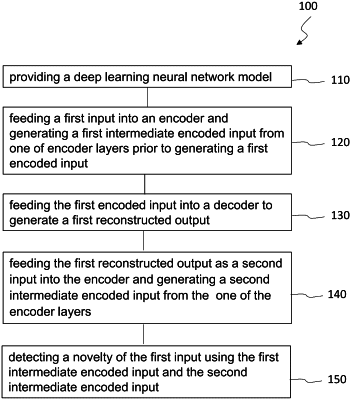| CPC G06N 3/088 (2013.01) [G06N 3/045 (2023.01)] | 15 Claims |

|
1. A method implemented on an electronic device for detecting novelty of sensor data using a deep learning neural network model, the method comprising:
providing the deep learning neural network model comprising an autoencoder on an electronic device, the autoencoder comprising an encoder comprising a plurality of encoder layers and a decoder comprising a plurality of decoder layers;
feeding a first input comprising the sensor data into the encoder and successively processing the first input through the plurality of encoder layers to generate a first encoded input, wherein successively processing the first input comprises generating a first intermediate encoded input from one of the encoder layers, by successively processing the first input through at least a subset of the plurality of encoder layers up to and including the one of the encoder layers, prior to generating the first encoded input;
feeding the first encoded input into the decoder and successively processing the first encoded input through the plurality of decoder layers to generate a first reconstructed output;
feeding the first reconstructed output as a second input into the encoder and successively processing the first reconstructed output through the at least the subset of the plurality of encoder layers up to and including the one of the encoder layers, wherein successively processing the first reconstructed output comprises generating a second intermediate encoded input from the one of the encoder layers,
wherein generating the first intermediate encoded input comprises generating a first vector and generating the second intermediate encoded input comprises generating a second vector, and wherein the first and second vectors have a lower dimension compared to the first input, and
wherein the first reconstructed output is not further processed through remaining ones of the encoder layers after generating the second intermediate encoded input from the one of the encoder layers;
computing a novelty score of the first input using the first intermediate encoded input and the second intermediate encoded input; and
outputting the novelty score.
|